inflation pressure AUDI A5 CABRIOLET 2015 Owners Manual
[x] Cancel search | Manufacturer: AUDI, Model Year: 2015, Model line: A5 CABRIOLET, Model: AUDI A5 CABRIOLET 2015Pages: 268, PDF Size: 66.88 MB
Page 122 of 268
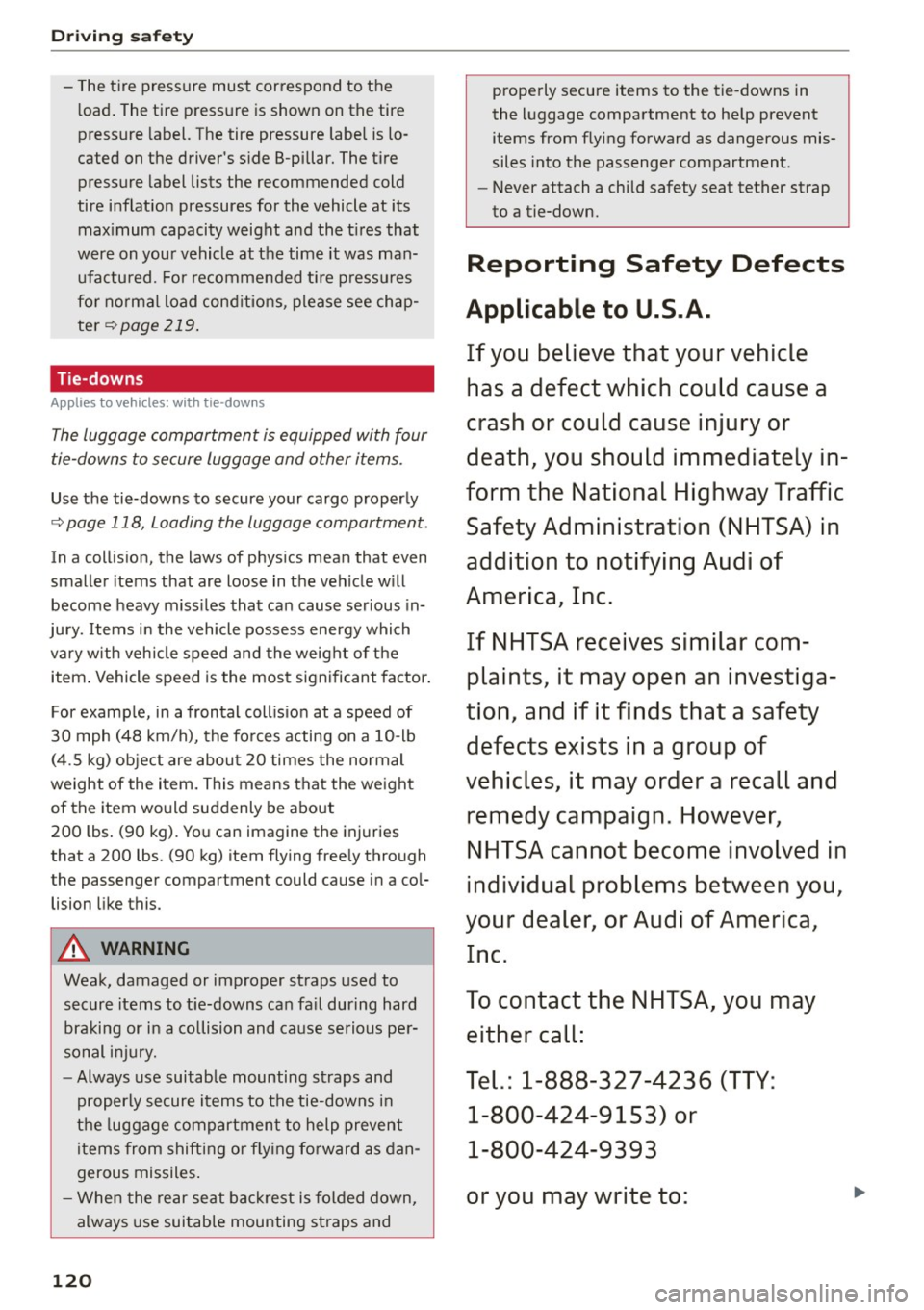
Driving safet y
- The tire pressure must cor respond to the
l oad . The tire press ure is shown on the tire
pressure label. The tire pressure labe l is lo
cated on the driver's s ide B-pillar. The tire
pressure label lists the recommended cold
tire inflation pressures for the vehicle at its max imum capacity weight and the t ires that
were on you r vehicle at the time it was man
ufa ctu red. For re comme nded ti re p ress ures
fo r normal load cond itions, please see chap
ter
<=> page 219 .
Tie-downs
Applies to vehicles: with tie-downs
The Luggage compartment is equipped with four
tie-downs to secure Luggage and other i tems.
Use the tie-downs to secure your cargo properly
<=> page 118, Loading the luggage compartment.
In a coll is io n, the laws of phys ics mean that even
smaller items that are loose in the vehicle w ill
become heavy m iss iles that can cause serious in
jury. Items i n the vehicle possess energy which
vary w ith vehicle speed and the weight of the
item . Vehicle speed is the most significant factor .
For examp le, in a frontal coll is ion at a speed of
30 mph (48 km/h), the fo rces acting on a 10-lb
( 4 .5 kg) obje ct are abou t 20 times the normal
weight of the item. This means that the we ight
of the item would suddenly be abo ut
200 lbs . (90 kg). Yo u can imagine the injuries
that a 200 lbs. (90 kg) item flying free ly through
t he passenger compartmen t could cause in a co l
lision like this.
A WARNING
Weak, damaged or improper straps used to
secure items to t ie-downs ca n fa il during hard
braking or in a collision and ca use serious pe r
sonal i njury.
- Always use suitable mounting straps and
properly secure items to the tie-downs i n
t h e luggage compartment to help prevent
items from shifting or f ly ing fo rward as dan
gerous missiles .
- When the re ar seat bac krest is folded down,
always use suitable mounting s traps and
120
-
properly secure items to the t ie-downs in
the l uggage compartment to help prevent
items from flying forward as dangerous mis
siles into the passenger compartment .
- Never attach a child safety seat tether strap
to a tie-down.
Reporting Safety Defects
Applicable to U.S.A.
If you believe that your vehicle
has a d efect which could cause a
crash or could cause injury or
death, you should immediatel y in
form the Nat ional High way Traffic
S afet y Administration (NH TSA ) in
addition t o notify ing Audi of
America, Inc.
If NHTSA re cei ves similar com
pl aint s, it ma y open an in ves tiga
tion , and if it find s that a safety
defe cts exists in a group of
v ehi cles, it ma y order a recall and
remed y campaign . Howe ver ,
NHTSA cannot become in vol ve d in
indi vidu al pr oblem s betw een you ,
your deal er, o r A udi of Am eri ca ,
In c.
To contact the NHTSA, you ma y
eith er call:
T el.: 1-888-327-4236 (TTY :
1 -800-424 -915 3) or
1 -800-424-9 393
or you may write to :
Page 213 of 268
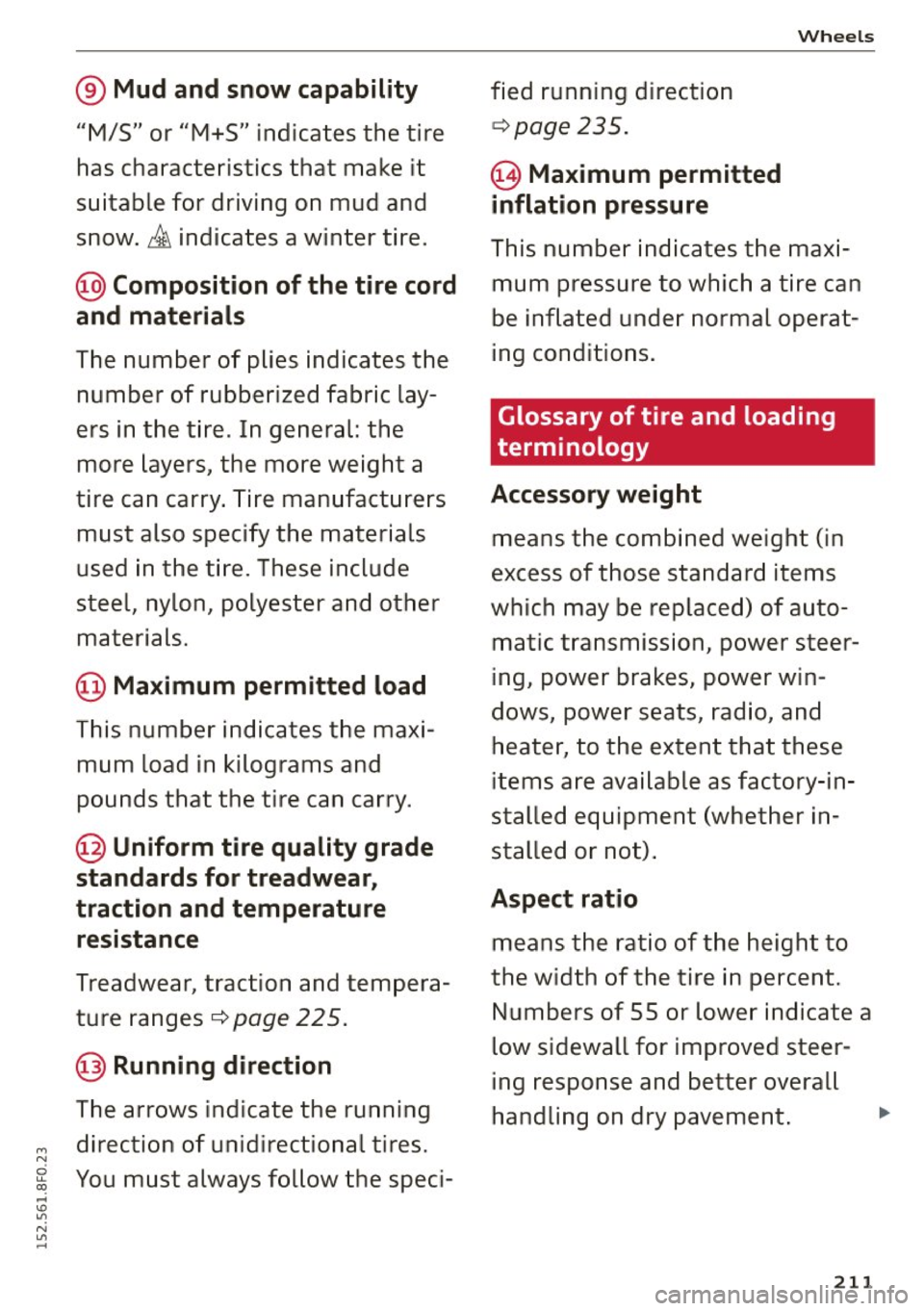
M N 0 u. "! ... IO "? N U'> .....
® Mud and snow capability
"M/S" or "M+S" indicates the tire
has characte ris tics that make it
suitable for driving on mud and snow .
& indica tes a winter tire.
@ Composition of the tire cord
and materials
T he number of plies indicates the
number of rubber ized fabric lay
ers in the tire . In general: the
more layers, the more weight a
tire can carry. Tire manufacturers
must also specify the mater ials
used in the tire. These include
stee l, nylon, polyester and other
materials.
@ Maximum permitted load
This number indicates the maxi
mum load in kilograms and
pounds that the tire can carry.
@ Uniform tire quality grade
standards for treadwear,
traction and temperature resistance
Treadwear , traction and tempera
ture ranges
c::::> page 225 .
@Running direction
The arrows ind icate the running
direction of unidirect ional tires.
You must always follow the speci- fied running direction
c::::> page 235.
€3) Ma
ximum permitted
inflation pressure
Whe els
This number indicates the maxi
mum pressure to which a tire can
be inflated unde r normal operat
ing conditions.
Glossary of t ire and loading
terminology
Accessory weight
means the combined weight (in
excess of those standard items
which may be replaced) of auto matic transmission, power steer
ing, power brakes, power win
dows, power seats, radio, and
heater, to the extent that these
items are available as factory-in
stalled equipment (whether in
stalled or not).
Aspect ratio
means the ratio of the height to
the width of the tire in percent. Numbers of 55 or lower indicate a
low s idewall for improved steer
ing response and better overall
handling on dry pavement . .,.
211
Page 214 of 268

Wheels
Bead
means the part of the tire that is
made of steel wires, wrapped or
reinforced by ply cords and that is
shaped to fit the rim .
Bead separation
means a breakdown of the bond
between components in the bead.
Cord
means the strands form ing the
plies in the tire.
Cold tire inflation pressure
means the tire pressure recom
mended by the vehicle manufac
turer for a tire of a designated
size that has not been driven for
more than a coup le of miles (kilo
meters) at low speeds in the three
hour period before the tire pres
sure is measured or adjusted .
Curb weight
means the weight of a motor ve
hicle with standard equipment in
cluding the maximum capacity of
fuel, oi l, and coolant , air condi
tioning and additional weight of optional equipment.
E x tra load tire
means a tire des igned to operate
at higher loads and at higher in-
2 12
flation pressures than the corre
sponding standard tire . Extra load
tires may be identified as "XL",
"xl", "EXTRA LOAD", or "RF" on
the sidewall.
G ross A xle Weight Rating
("GAWR ")
means the load-carrying capacity
of a single axle system , measured
at the tire-ground interfaces .
Gross Vehicle Weight Rating
( "GVWR" )
means the max imum total loaded
weight of the vehicle .
Groove
means the space between two ad
jacent tread ribs .
Load rating (code )
means the max imum load that a
tire is rated to carry for a given in
flation pressure . You may not find
this information on all tires be cause it is not required by law.
Ma ximum load rating
means the load rating for a tire at
the maximum permissible infla
tion pressure for that tire .
Maximum loaded vehicle
w eight
means the sum of: ...
Page 215 of 268

M N 0 u. "! ... IO "? N U'> .....
(a) Curb weight
(b) Accessory weight
(c) Vehicle capacity weight, and
(d) Product ion options weight
Maximum (permissible)
inflation pressure
means the max im um cold infla
tion pressu re to which a tire may
be inflated . Also called "maxi
mum inflation pressure ."
Normal occupant weight
means 150 lbs . (68 kilog rams)
times the number of occupants
seated in the veh ic le up to the to
tal seating capacity of yo ur vehi
c le.
Occupant distribution
means d istr ibution of occupants
in a vehicle.
Outer diameter
means the overall diameter of an
inflated new tire .
Overall width
means the linear dis tance be
tween the exter iors of the side
walls of an inflated tire, including
elevations d ue to labe ling, deco
rations , or protective bands or
ribs .
Whee ls
Ply
means a layer of rubbe r-coated
parallel cords .
Production options weight
means the comb ined weight o f
those installed regular production
options weighing over 5 lbs . (2 .3
kg) in excess o f those s tandard
items which they re place , not pre
viously conside red in cu rb weight
or accessory weight, including heavy duty brakes, ride levelers,
heavy du ty bat tery, and special
trim .
Radial ply tire
means a pneumat ic t ire in which
the ply co rds that ex tend to the
beads are laid at substantially 90
degrees to t he ce nterli ne of the
tread .
Recommended inflation
pressure
see ~ page 212, Cold tire infla
tion pressure .
Reinforced tire
means a tire designed to operate
at higher loads and at h igher in
flat ion pressures than the corre
sponding standard tire . Rein
f orced tires may be identified as
2 13
Page 218 of 268
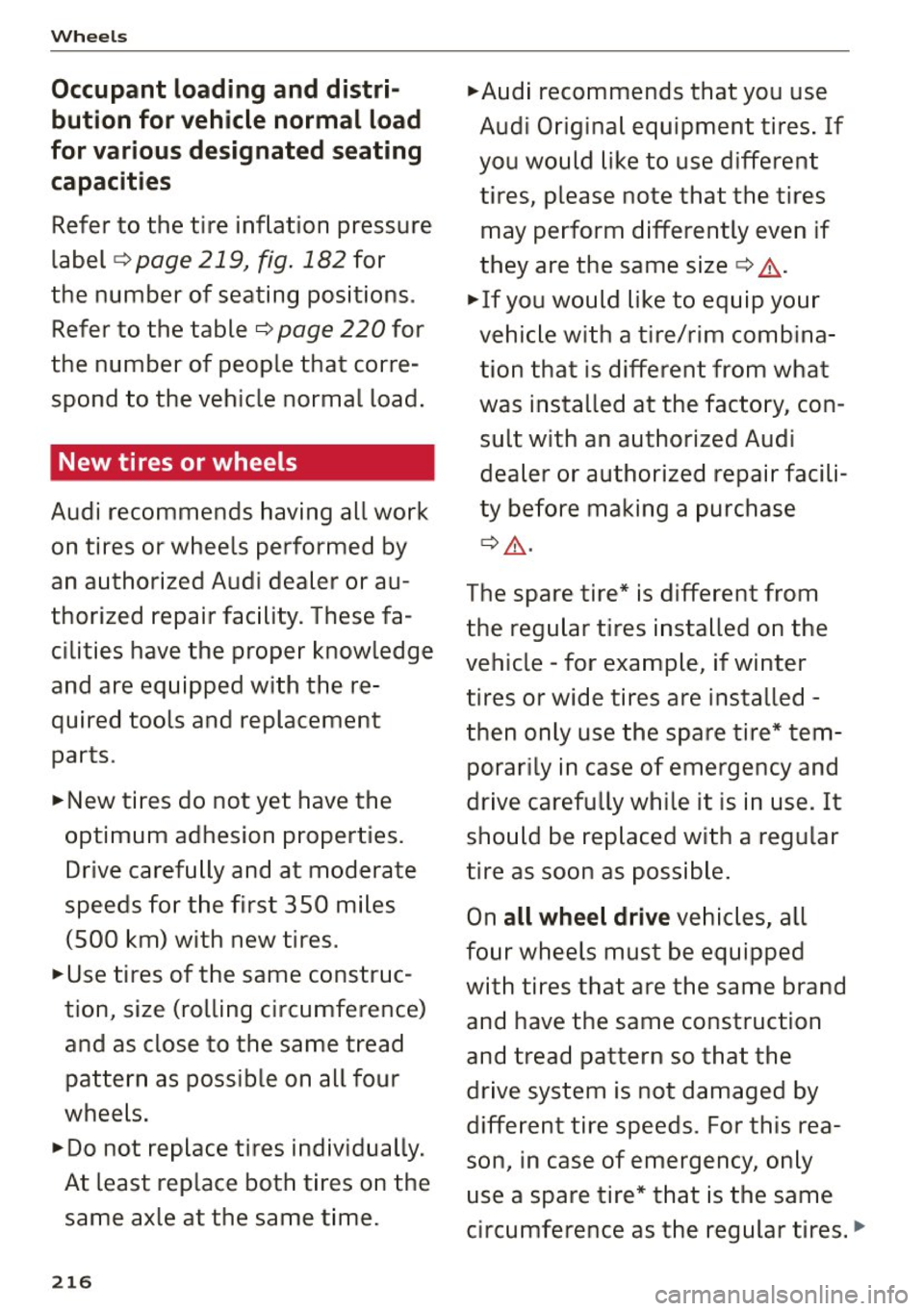
Wheels
Occupant loading and distri
bution for veh icle normal load
for various designated seat ing
capacit ies
Refer to the tire inflation pressure
label
c:> page 219, fig . 182 for
the number of seating positions .
Refer to the table
c:> page 220 for
the number of people that corre
spond to the vehicle normal load .
New tires or wheels
Audi recommends having all work
on tires or wheels performed by
an authorized Audi dealer or au
thorized repair facility. These fa
cilities have the proper knowledge
and are equipped with the re
quired tools and replacement
parts .
.,.N ew tires do no t yet have the
optimum adhesion properties.
D rive carefu lly and at moderate
speeds fo r the first 350 miles
(500 km) with new tires.
.,. Use tires of the same construc
tion, size (rolling circumference)
and as close to the same tread
pattern as possib le on all four
wheels.
.,. Do not replace tires individually.
At least replace both tires on the same axle at the same time .
216
.,.A udi recommends that yo u use
Aud i O rig ina l equipment tires . If
you would like to use different t ir es, please note that the ti res
may pe rform differently even if
they are the same size
c:> A -
.,. If you would li ke to equ ip your
vehicle with a tire/rim combina
t ion tha t is different from what
was installed at the facto ry, con
sult with an authorized Audi
dea ler or authorized repa ir facili
ty before making a purchase
¢ ,&. .
The spare tire* is different from
the regular tires installed on the
vehic le - for examp le, if winter
tires or wide t ires are insta lled -
then only use the spare tire* tem
porarily in case of eme rgency and
drive carefully wh ile it is in use. It
s h o ul d be rep laced wi th a regular
tire as soon as poss ib le .
On
all wheel drive vehic les, all
four wheels must be equipped
with tires that are the same brand
and have the same construction
and tread pattern so that the
dr ive system is not damaged by
diffe rent tire speeds. For this rea
son, in case of emergency, only
use a spa re tire* that is the same
circumference as the regular tires . .,.
Page 219 of 268
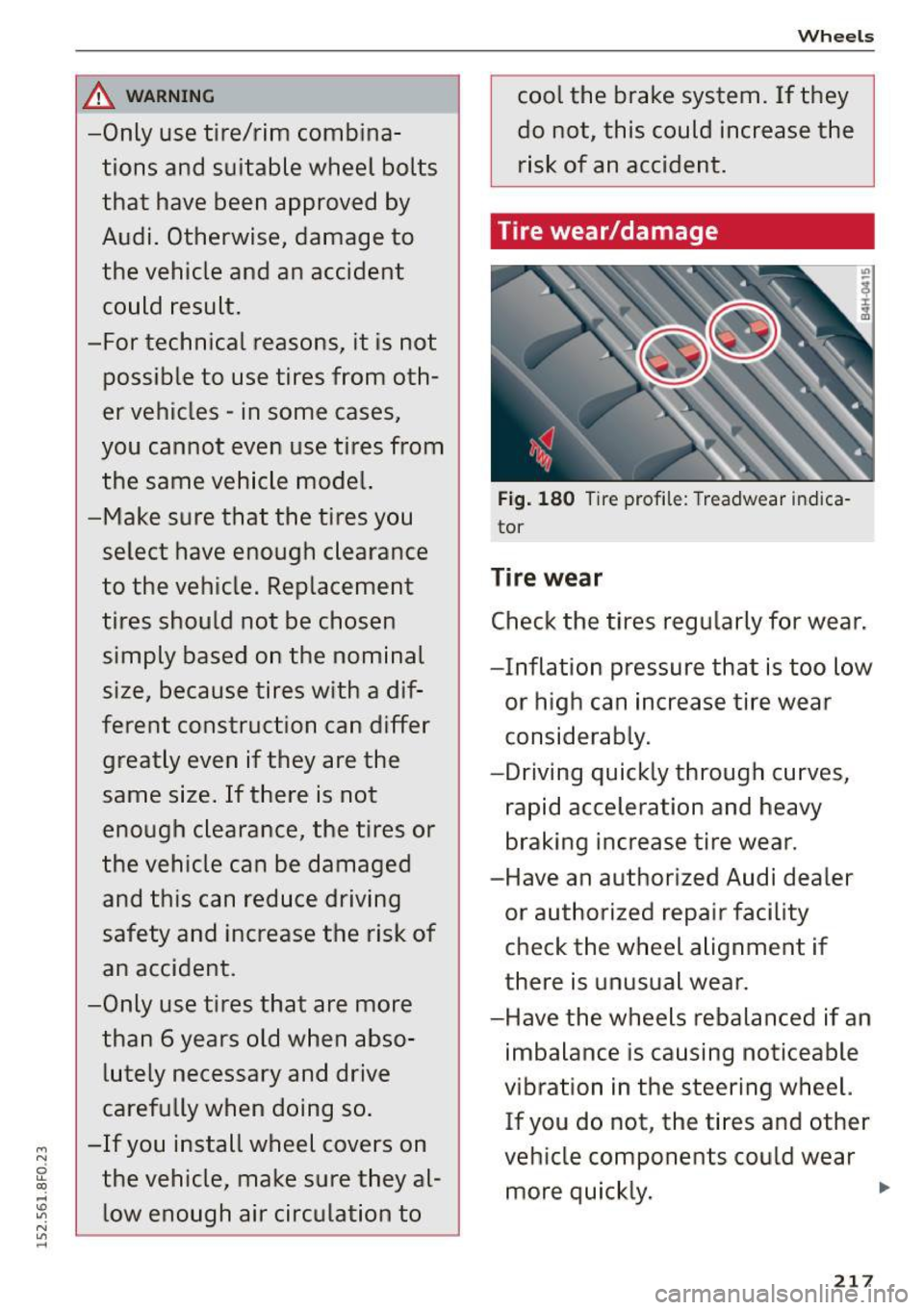
_& WARNING -
-Only use tire/rim combinations and suitable wheel bolts
that have been approved by
Audi. Otherwise, damage to
the vehicle and an accident
could result.
- For technical reasons, it is not
possible to use tires from oth
er vehicles -in some cases,
you cannot even use tires from
the same vehicle model.
- Make sure that the tires you
select have enough clearance
to the vehicle. Replacement
tires should not be chosen simply based on the nominal
size, because tires with a dif
ferent construction can differ
greatly even if they are the
same size. If there is not
enough clearance, the tires or
the vehicle can be damaged
and this can reduce driving
safety and increase the risk of
an accident.
-Only use tires that are more
than 6 years old when abso
lutely necessary and drive
carefully when doing so.
-If you install wheel covers on
the vehicle, make sure they al low enough air circulation to
Wheels
cool the brake system. If they
do not, this could increase the
risk of an accident.
Tire wear/damage
Fig. 180 Tire profile: Treadwear indica
tor
Tire wear
Check the tires regularly for wear.
- Inflation pressure that is too low
or high can increase tire wear
considerably.
-Driving quickly through curves,
rapid acceleration and heavy
braking increase tire wear.
- Have an authorized Audi dealer
or authorized repair facility
check the wheel alignment if
there is unusual wear.
-Have the wheels rebalanced if an imbalance is causing noticeable
vibration in the steering wheel. If you do not, the tires and other
vehicle components could wear more quickly.
217
...
Page 225 of 268

M N
ci u.. co ,...., \!) 1.1'1
N 1.1'1 ,....,
Determining correct load
limit
Use the example below to calcu
late the total weight of the pas
sengers and luggage or other
things that you plan to transport
so that you can make sure that
your vehicle will not be overload ed.
Steps for Determining Correct Load Limit
1. Locate the statement "THE
COMBINED WEIGHT OF OCCUPANTS AND CARGO SHOULD
NEVER EXCEED XXX KG OR XXX
LBS"on your vehicle's placard
(tire inflation pressure label)
¢page 219, fig. 181.
2. Determine the combined
weight of the driver and pas
sengers that will be riding in
your vehicle.
3. Subtract the combined weight of the driver and passengers
from
"XXX" kilograms or "XXX"
pounds shown on the sticker
¢page 219, fig. 181.
4. The resulting figure equals the
available amount of cargo and luggage load capacity. For ex
ample, if the
"XXX" amount
equals 1400 lbs. and there will
Wheels
be five 1 SO lbs. passengers in
your vehicle, the amount of available cargo and luggage load capacity is 650 lbs.
(1400-750 (5 X 150) = 650
lbs.)
5. Determine the combined
weight of luggage and cargo
being loaded on the vehicle.
That weight may not safely ex
ceed the available cargo and
luggage load capacity calculat
ed in Step 4.
6. If your vehicle will be towing a trailer, load from your trailer
will be transferred to your vehi
c le. Consult this manual to de
termine how this reduces the
available cargo and luggage load capacity of your vehicle.
.,.Check the tire sidewall
(¢ page 209, fig. 179) to deter
mine the designated load rating
for a specific tire.
Wheel bolts and rims
Wheel bolts
Wheel bolts must be clean and loosen/tighten
easily.
Rims
Rims with a bolted rim ring* or with bolted wheel
cov ers* consist of multiple pieces. These compo
nents were bolted together using special bolts
and a special procedure . You must not repair or
disassemble them
i::> Li::,.. ..,.
223
Page 227 of 268
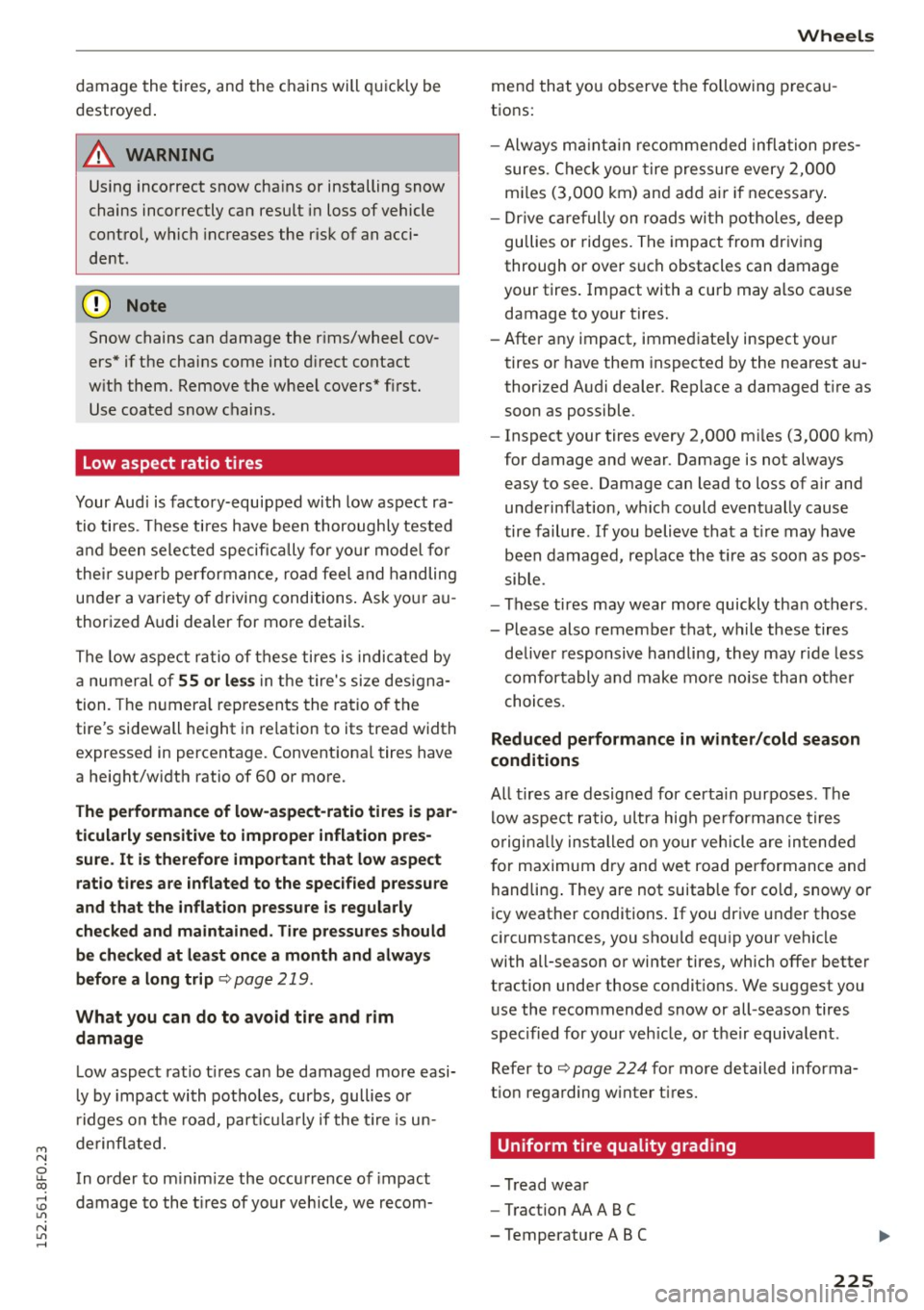
M N
ci u.. co ,...., \!) ..,.,
N ..,., ,....,
damage the t ires, and the c hains will quickly be
destroye d.
A WARNING
Using inco rrect snow cha ins or installing snow
chains incorrectly can resu lt i n loss of vehicle
cont ro l, whic h increases the r isk of an acci
de nt.
(D Note
Snow chains can dama ge the r ims/whee l cov
ers * if th e cha ins come into d irect contact
w it h them. Remove the whee l cov ers* f irst .
Use coat ed snow c hains.
Low aspect ratio tires
Your Au di is factory -equip ped wi th low as pect ra
tio ti res. T hese ti res have bee n thoroughly teste d
a nd been se le cted specific ally fo r your model fo r
t he ir su perb pe rformance, road feel and handling
u nd er a variety o f driving conditions . Ask yo ur au
thor ized A udi dealer for mo re deta ils.
The low aspe ct r atio of these ti res i s indic ated by
a numer al of
55 or les s in th e tire's si ze des igna
tion. The nu mera l represen ts the ra ti o of the
tire's sidewall he ight in relation to its trea d width
e x pressed in percentage. Convent io na l tires have
a he ight/w idth ratio of 60 or mo re.
The performance of low-aspect-ratio tires is par
ticularly sensitive to improper inflation pres
sure . It is therefore important that low aspect
ratio tires are inflated to the specified pressure
and that the inflation pressure is regularly
checked and maintained . Tire pressures should
be checked at least once a month and always
before a long trip
¢ pag e 219.
What you can do to avoid tire and rim
damage
L ow aspec t rat io t ires ca n be damaged more easi
l y by impact wi th pot ho les, curbs, gulli es or
r idges on the road, par ticularly if the tire is un
de rin fla ted.
In o rder to m inim ize the occu rrence o f impact
damage to the t ires of your v ehicl e, we recom-
Wheels
me nd that yo u observe the follow ing p recau
t ions:
- Alw ays m aintain r eco m me nded infl ation pre s
sures. C heck your tire pressure every 2,000
m iles (3,00 0 km) an d ad d air if necessary .
- Dr ive c arefully on road s wi th pot holes, deep
gu llies o r ridges. The impac t from dr iv ing
through or over s uch obstacles can damage
your tires . Impact with a curb may a lso ca use
damage to your tires .
- After a ny impact, imme diate ly inspect yo ur
tires o r have them inspected by the nearest au
thorized A udi dealer. Rep lace a damaged t ire as
soon as possible.
- Inspect your tires every 2,000 m iles (3,000 km)
for damage and wear . Damage is not always
easy to see. Damage can lead to loss of air and
unde rinflation, w hich could even tually cause
t ire failure .
If you beli eve that a t ire may have
been damaged, re place the t ire as soon as pos
s ible.
- These ti res may wear more quickly tha n oth ers .
- Please also remember that, wh ile these tires
delive r responsiv e han dling, they may r ide less
comfortably and make mo re no ise than other
c h o ic e s.
Reduced performance in winter/cold season
conditions
All t ir e s ar e designed for certa in purpos es. T he
l ow asp ect ra tio, ultr a hig h perfor man ce tire s
o rigi nall y insta lled on y our veh icle are in tende d
f or m aximum dry an d we t road pe rformance and
handli ng. They are not suitab le for co ld , snowy or
icy weather conditions . If you dr ive under those
c ircumstances , you sho uld eq uip your vehicle
with all-season or winter tires, which offer better
t raction unde r those co ndit io ns. We suggest you
u se the recommended snow or all-seaso n tires
spec ified for your veh icle, o r the ir equiva le nt.
Refer to¢
page 224 for more detailed informa
t ion regarding w inte r tir es.
Uniform tire quality grading
- Tread wea r
- Traction AA AB C
- Temperature AB C
225
Page 228 of 268
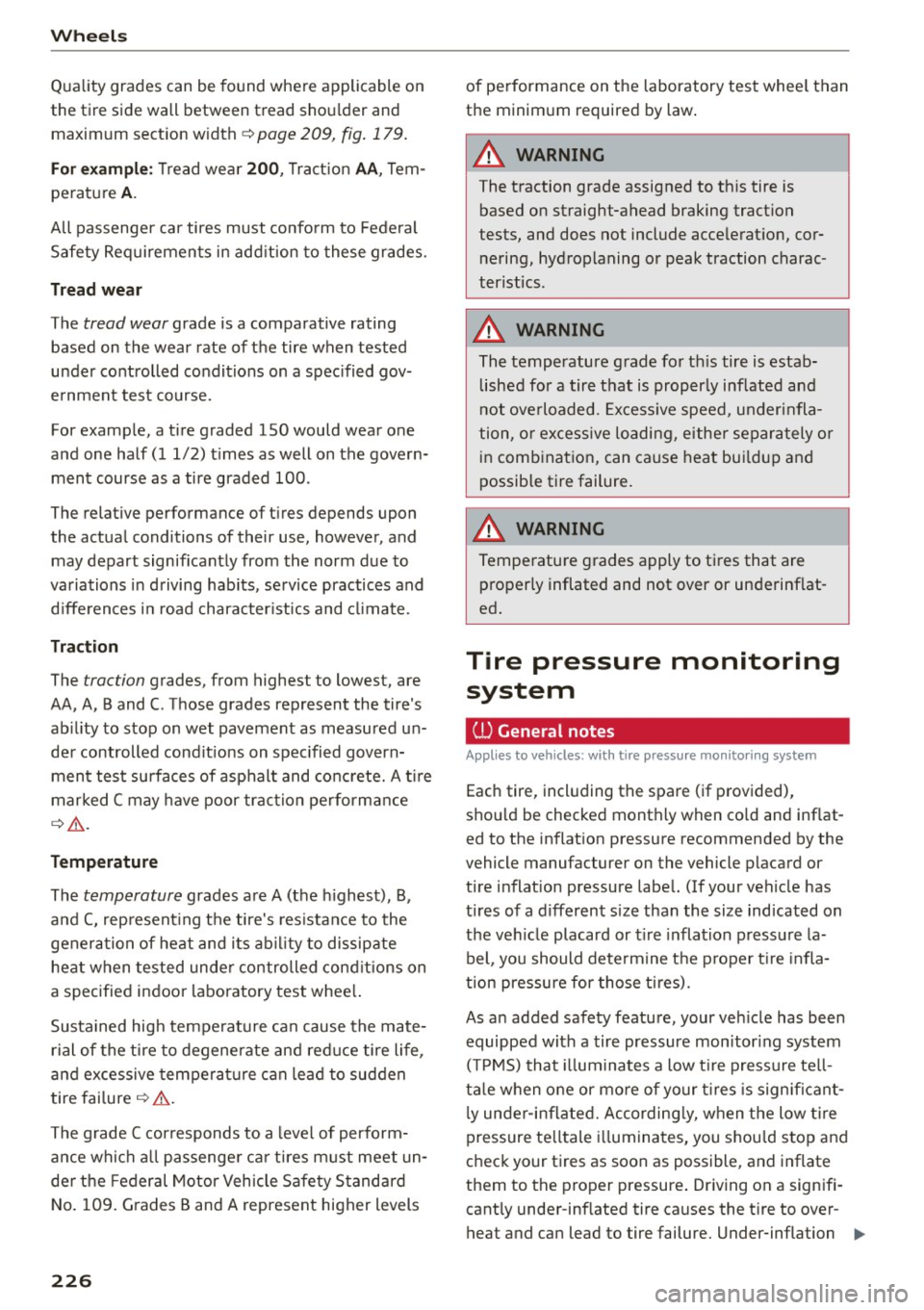
Wheels
Quality grades can be found where applicable on
the tire side wall between t read sho ulder and
maximum sect ion w idth
c::> page 209, fig . 179.
For example: Tr ead wear 200 , Tract ion AA, Tem
peratu re
A .
All passenger ca r tires must confo rm to Federal
Safety Req uiremen ts in add it ion to these grades.
Tread wear
The tread wear grade is a comparative rating
based on the wear rate of the tire when tested
unde r controlled conditions on a spec ified gov
ernment test course.
For examp le, a t ire graded 150 would wear one
and one half ( 1 1/2) t imes as well on the govern
ment course as a tire graded 100 .
The relat ive performance of t ires depends upon
the actua l conditions of their use, however, and
may depart significantly from the norm due to
variations i n driving hab its, service practices and
d iffe rences in road character istics and clima te.
Traction
The traction grades, from highest to lowest, are
AA, A , Band
C. Those grades represent the tire's
ab ility to stop on wet pavement as measu red u n
de r controlled cond it ions on spec ified govern
ment test su rfaces of asphalt and concrete. A tire
marked C may have poor traction performance
c::> &_ .
Temperature
The temperature grades are A (the highest), B,
a nd C, rep resent ing t he tire's res istance to the
genera tion of heat and its a bility to dis sipate
heat w hen tested unde r controlled cond itions on
a specified indoo r laboratory test whee l.
Sustained high temperature can cause the mate rial of the tire to degenerate and red uce tire life,
a nd excessive tempera ture can lead to sudden
tire failure
c::> &. .
The grade C co rresponds to a level of perform
ance wh ich a ll passenge r ca r tires m ust meet un
de r th e Federal Motor Vehicle Safety S tandard
No. 109. G rades Band A represent higher levels
226
of pe rformance on the laboratory test whee l than
the minimum required by law .
A WARNING -
The traction grade assigned to th is tire is
based on straight-ahead braking tract ion
tests, and does not include acce lerat ion, cor
nering, hyd roplaning or peak traction charac
teristics.
A WARNING
The temperature g rade for th is tire is estab
lished for a tire that is properly inf lated and
n ot ove rloaded. Excess ive speed, underi nfla
tion, o r ex cess ive lo adi ng, eithe r separately or
i n comb inat io n, can ca use heat bu ild up and
possible tire failure.
A WARNING
Tempe ratu re grades apply to ti res that are
properly inflated and not over or underinflat
ed.
Tire pressure monitoring system
(l) General notes
App lies to vehicl es: wi th tire p ress ure mo nito rin g system
-
Each tire, incl uding the spare (if provided),
sho uld be checked monthly when co ld and inflat
ed to the inflat ion pressure recommended by the
vehicle manufacturer on the vehicle placard or
tire inflat ion pressure label. (If your vehicle has
tires of a different s ize than the size indicated on
the ve hicle placard or t ire inflation pressu re la
bel, you should dete rm ine the p roper t ire infla
tion pressu re for those t ires).
As a n added safety feature, your ve hicle has been
equipped with a tire pressure mon itor ing system
( TP MS) that illum inates a low t ire pressure te ll-
ta le w hen o ne or mo re of yo ur ti res is sign ificant -
l y unde r-i nflated. According ly, w hen t he low t ire
pressure te lltale illuminates, you shou ld stop and
check yo ur tires as soon as possible, and inflate
them to the proper pressure . Dr iving on a signifi
cant ly under-inf lated tire causes the t ire to over
heat and can lead to tire failure. Under-inflation .,,.
Page 229 of 268

M N
ci u.. co ,...., \!) ..,.,
N ..,., ,....,
also reduces fuel efficiency and tire tread life,
and may affect the vehicle's handling and stop
ping ability .
Please note that the TPMS is not a substitute for
proper tire maintenance, and it is the driver's re
sponsibility to maintain correct tire pressure,
even if under-inflation has not reached the level
to trigger illumination of the TPMS low tire pres
sure telltale.
Your vehicle has also been equipped with a TPMS malfunction indicator to indicate when the sys
tem is not operating properly. The TPMS mal
function indicator is combined with the low tire pressure telltale . When the system detects a
malfunct ion, the telltale will flash for approxi
mately one minute and then remain continuously
illuminated. This sequence will continue upon
subsequent veh icle start-ups as long as the mal
function exists.
When the malfunction indicator is illuminated,
the system may not be able to detect or signal
low tire pressure as intended. TPMS malfunctions
may occur for a variety of reasons, including the
installation of replacement or alternate tires or
wheels on the vehicle that prevent the TPMS
from functioning properly. Always check the
TPMS malfunction telltale after replacing one or more tires or wheels on your vehicle to ensure
that the replacement or alternate tires and
wheels allow the TPMS to continue to function properly.
Wheels
If the Tire Pressure Monitoring System
indicator appears
Appl ies to vehicles : wi th t ir e p ress ure mo nito rin g system
The tire pressure indicator in the instrument
cluster informs you if the tire pressure is too low
or if there is a system malfunction.
Fig. 183 Instrument cluster: i ndicator light with message
Using the ABS sensors, the tire pressure monitor
ing system compares the tire tread circumference
and vibration characteristics of the individual
tires .
If the pressure changes in one or more
tires, this is indicated in the instrument cluster
display with an indicator light
[I] and a message .
If only one tire is affected, the location of that
tire will be indicated .
The tire pressures must be stored in the Infotain
ment system again each time the pressures
change (switching between partial and full load
pressure) or after changing or replacing a tire on
your vehicle ¢
page 228. The tire pressure moni
toring system only monitors the tire pressure you have stored. Refer to the tire pressure label for
the recommended tire pressure for your vehicle
r=> page 219, fig . 182.
Tire tread circumference and vibration character
istics can change and cause a tire pressure warn
ing if:
- the tire pressure in one or more tires is too low .
- the tire has structural damage.
- the tir e was replaced or the tire pressure was
changed and it was not stored ¢
page 228.
-the spare t ire* is installed.
Indicator lights
[I] Loss of pressure in at least one tire¢.& .
Check the tires and replace or repair if necessary .
liJJ,-
227